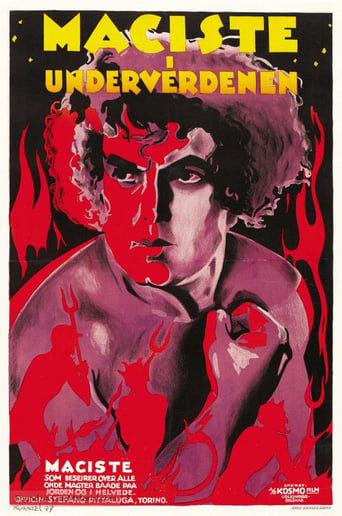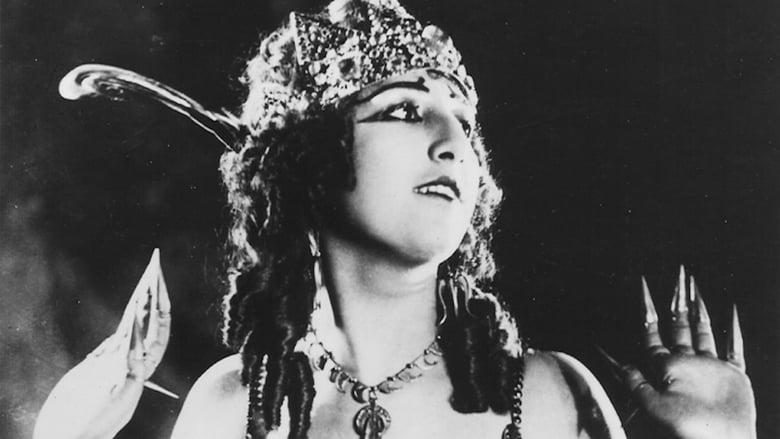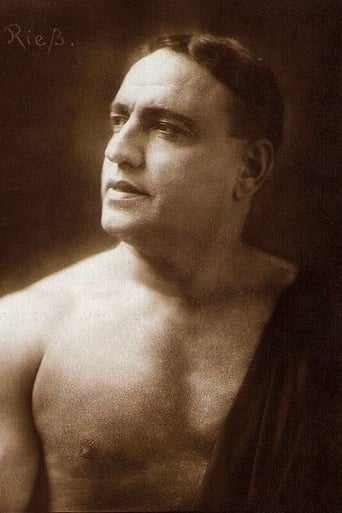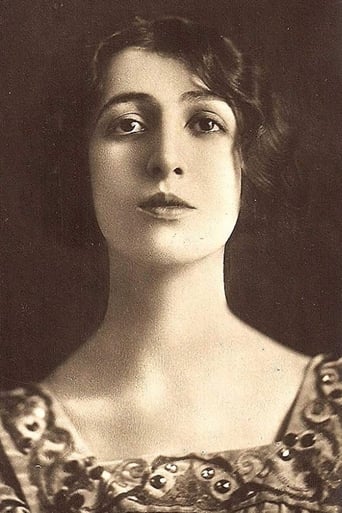

Maciste in Hell (1925)
The devil takes Maciste down to hell in an attempt to corrupt and ruin his morality.
Watch Trailer
Cast
Reviews
The Age of Commercialism
There are moments that feel comical, some horrific, and some downright inspiring but the tonal shifts hardly matter as the end results come to a film that's perfect for this time.
It is interesting even when nothing much happens, which is for most of its 3-hour running time. Read full review
It's a good bad... and worth a popcorn matinée. While it's easy to lament what could have been...
Seeing as how the 1962 remake of this film is one of my absolute favourites, I felt it was only fair to go back and give the original a try. Boy, was I in for a surprise! While Riccardo Freda's later movie was an entry in the sword-and-sandal genre with loincloth-clad strongman Kirk Morris raising merry hell in, well, Hell, this is more of a fantasy adventure type story. Here, Bartolomeo Pagano plays Maciste, a normal, everyday, (then) modern guy – dressed in clothes and everything – living in the country, who happens to be extremely strong and powerful. Pagano played the character for decades and in dozens of movies, so he fits his role like a glove here.One thing I couldn't believe was this old, creaky, silent film's budget. It must have been massive, because this feels like an epic! The scenes in Hell are tremendously well-staged, as we witness dozens of demons flying around in the air; a huge dragon, just as good as the ones you saw in the '60s; numerous kings and assorted characters of the underworld, all from mythology or legend; massive pitched battles as Maciste smacks his way through crowds of lesser demons, flinging them through the air; plus plenty more besides. There are explosions, smoke, and wonderful scenes in which demons return their missing heads and re-grow their smashed faces. The story is easy to follow because there are lots of storyboard bits which tell you what's going on, and there's even some touching morality thrown in. Fans of silent cinema will no doubt have a ball with this effort, one of the most imaginative and entertaining that I've seen from the era.
I am going to try to convince you all that love is evil... at least in this picture it is.because of the bad projection, I saw more corpses on the screen than living creatures, but maybe it's because this movie was strong horror in its time. anyway, the story is a bit like the one we all know, the Faust dilemma.the situation of wanting to do everything for the one we love, can bring us torment and strong agony (this movie seems to say). if you forgive the wrongs of your love, you are cursed with your own pity... really? must we always believe in God and never follow our 'humble' Devil? are there demons among us and if so, are we one of them? in fact, the simple story of this film leaves us with more questions than answers (espacially the Spartacus-like ending). the message seems to be that if we do what we believe is right for the one we love, we can be able to do terrible things, even without knowing it ourselves.so Star Wars is right: love is the devil. you will never forget the devil in this picture. he's so cliché, but like that, we all will remember him (and the demons on the screen or in the 'war', that looks a lot like the rape scene in Flaming Creatures).but nowadays, this picture is terrible old and the effects does not always work very well. if you want to do yourself a favor, do not see this picture.
"Our hero Maciste saves a young child from the grips of a demon and decides to take the fight to the demon's home. Maciste travels to the depths of Hell, in order to tack down the Devil, to stop the evil from spreading across the Earth. Maciste struggles with many different perils along his trip into Hell and appears to be defeated, if not for an act of kindness from a friend," according to the DVD sleeve's synopsis.Its Hellish netherworld scenes are the highlight of Guido Brignone's "Maciste all'inferno". The storyline doesn't seem to be very well thought out, however. While some suffer, most of Hell's denizens seem to be having a grand time. Oddly placed, Bartolomeo Pagano (as Maciste) is an incredible success in Hell; he is especially popular with the women of the underworld, who enjoy his kisses. Still, Mr. Pagano wants to return to his serene life on Earth. Who will show him the way? ***** Maciste all'inferno (10/19/25) Guido Brignone ~ Bartolomeo Pagano, Elena Sangro, Franz Sala
Since I was going through some of the low-brow Italian peplums of the 50s and 60s over the Easter period, I decided to watch this Silent epic (also made in Italy) simultaneously. However, it turned out to not really be a peplum after all despite the muscular title character (protagonist of a long-running series of films and, here, somewhat incongruously sporting modern attire including a suit and tie!) and the fact that the Italians had actually pioneered the religious epic genre during the Silent era! That said, I guess I should have known since I had already watched Riccardo Freda's colorful but disappointing 1962 semi-remake (actually set against a 17th Century Puritan backdrop) but, there at least, Maciste is still somehow fitted with the traditional loincloth Anyway, to get to the movie itself: since I hadn't previously watched any of the Silent Italian epics, I didn't quite know how well it would have worn the passage of time but, surprisingly, I was left reasonably impressed by the visual splendor of the production which often evoked medieval paintings particularly in its hellish sequences. In fact, as I watched the film, I was most reminded as had been another viewer writing on the IMDb of Benjamin Christensen's HAXAN (1922) and F.W. Murnau's FAUST (1926) which, I'm sure you'll agree, is high praise indeed for a film of this kind! Besides, the human form taken by the devil Barbariccia (literally "Curlybeard") and his minions evokes memories of Scapinelli, the Mephistophelean figure of "The Student Of Prague" (a German folk-tale filmed twice, at least, during the Silent era) The plot of the film proper Maciste is apparently a do-gooder whose activities are giving Hell a bad name, so a devil is sent to Earth in order to tempt him; somehow, the former ends up in the underworld and, giving in to the affections of some devilish sirens, is himself turned into a hellish creature until saved by a child's prayer on Christmas Eve! is quaint yet curiously effective, especially given the myriad unconvincing-looking demons Maciste has to face; at one point, there's even a revolt (never fully explained, at least in the 66-minute print I watched) against Barbariccia's dominion in Hell which is an interesting way of saying that petty jealousies and machinations, the cause of so much evil on Earth, are present in the afterlife as well! I don't recall the 1962 film enough to make comparisons, except to say that it was an unintentional laugh-riot, but also that the plot of the later version is quite different as it involves a reanimated witch who had been burned at the stake (in fact, it was called THE WITCH'S CURSE in the U.S.); I know, however, that I enjoyed the 'original' a good deal and am certainly interested now in seeking out more Silent spectacles from Italy L'INFERNO (1911), THE LAST DAYS OF POMPEII (1913), CABIRIA (1914), etc.


